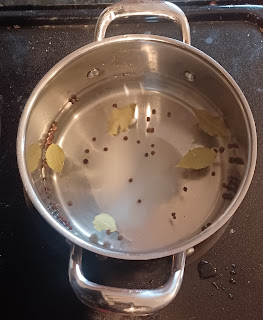A couple of weeks ago I wrote about some of my favourite Czech pub snacks, which left me in something of an nostalgic reverie. When Mrs V and I lived in Prague our Sunday tradition was to take a number 6, 8, or 26 tram from Masarykovo nádraží to Strossmayerovo náměstí and from there a number 17 to Trojská. Once at Trojská we would walk along the river, practically to the zoo and then cross the river Vltava into the expansive Stromovka park, once the hunting grounds of toffs. Having walked through Stromovka we would be near Letenské náměstí and would often have brunch at a restaurant called Fraktal before continuing our walk through the park at Letna, then down the hill, across Čechův most, and into Prague's Old Town to find a pub to sit in and fritter away the afternoon.
As a result of both the reverie and my post, I decided I needed to make some utopenci again. As I mentioned in the post, "utopenec" (singular) translates as "drowned man" in Czech, a name that allegedly comes from a Bohemian story about a pub owner and miller. The legend goes that in the town of Beroun, coincidentally one of Mrs V and I's favourite day trips from Prague for their ceramic festival, there once lived a man by the name of Šamánek, whose boozer was well regarded for the quality of the pickled sausages it served. One day, our friend Šamánek was making repairs to the waterwheel that powered his mill and had the misfortune of falling into the water and drowning. Henceforth the pickled sausages sold at his pub were called, rather darkly, after his misfortune to become a drowned man.
Several friends asked if I could share with them how to make utopenci (plural), and so when I got round to making a new batch at the weekend, I figured I'd take some pictures and put it all here. So...for the recipe you will need:
- 1 packet of spicy smoked sausage
- 2 medium onions
- 2 Hungarian wax peppers
- 2 cups white vinegar
- 2 cups water
- 0.5 teaspoon salt
- 1 tablespoon sugar
- 0.5 teaspoon allspice berries
- 0.5 teaspoon black peppercorns
- 4 or 5 bay leaves
The traditional Czech sausage used in utopenci is called a špekáček (singular), which is a short, fat smoked sausage that is a mix of beef and pork. The Wegman's Smoked Hungarian style sausage below is the closest I have found to špekáčky (plural).
Before dealing with the sausages themselves though, we need to make the brine. In a smallish pot, mix the vinegar, water, salt, sugar, and spices then bring to the boil. Boil hard for 3 minutes, remove the pot from the heat, and let the brine cool. You don't want to pour boiling brine over the sausages, we are pickling not cooking them remember.
While the brine is cooling, prepare the sausages and vegetables. I cut one end off the sausages purely so they fit better in the type of jar I generally use. Finely slice the onions and peppers.
Next up split the sausages lengthwise without cutting all the way through to the other side and stuff them with slices of onion and pepper.
Once the brine is lukewarm, it is time to fill your jar with more sliced onions and peppers, and add the stuffed sausages so that you have a pretty well packed jar.
Before pouring the brine into the jar, I take a spoon to remove the allspice, peppercorns, and bay leaves, which I then add to the jar so they can macerate further and add more flavour. Gently pour in the brine to cover the sausages completely, using a chopstick or similar to allow the spices to penetrate further into the jar. Once full, tap the jar on the counter surface a few times to get rid of any air pockets.
Pop a lid on the jar and put it into the fridge to forget about for at least 10 days, though 2 weeks is my preferred minimum.
When it is time to eat them, just pull out a sausage, some of the veggies, which will have pickled nicely as well, and serve with a dollop of mustard, a couple of slices of seeded rye bread, and a half litre of some properly made Bohemian style pilsner, Pilsner Urquell would do the trick nicely.
Note: there is another theory as to the origin of the name, but it is less prosaic and hence, sadly, more likely, simply that the floating sausages look like drowned men. Meh, I prefer the story of Šamánek.

















